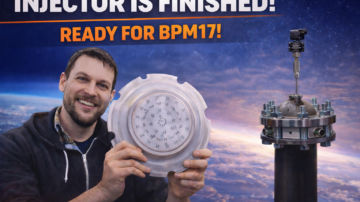Dear Rocketfans
We need your thoughts and ideas
A while ago, we had some tests to investigate the best landing configuration of the space capsule, to minimize the forces that our astronout will be exposed to. To do this we 3D printed a model of the space capsule, with two different end caps; a blunt “Apollo style” end cap and a cone-shaped end cap.

In the model we placed a sensor that could measure the accelerations at a frequency of 5000Hz.
Preparations
The test setup was relatively simple. We cut off the top of a pallet tank, filled it with water, and during the test we placed a set of cameras above and below the water.

The drop itself was done by hanging the model at fixed height, at an angle created by a set of strings that forced the specific angles we wanted to test, from vertical to horizontal at 10 degree intervals.

Challenges!
And now to the exciting part. Prior to the test, we expected to see reduced forces with the cone-shaped bottom. We also expected to see reduced forces with the blunt end cap if the space capsule landed at an angle.

But how big the effects were, and what their mutual relation would be, was what we looked forward to investigate.
The results
This test wasn’t meant as scaled test, in order to predict the actual forces that the astronaut will experience, but rather a comparative test to get closer to understand what combination of end cap and landing angle would give the least accelerations to the astronaut. So please don’t put too much emphasis on the size of the values, but rather on the interrelationship between them.
Below you can see the results from the many drops we did. each dot represents numerous drops, to get a good data set. The graph shows the sum of accelerations of the three axis. the orange line represents the measurements with the blunt end cap, and the blue represents the cone-shaped end cap. For the cone-shaped end cap we were only interested in the vertical drops, but for the sake of further comparison, we did some more drops with the smaller angles.
The angles of the space capsule are represented on the X-axis, where vertical is 0 degrees and a horizontal landing ( equivalent to the astronaut landing on the back) is 90 degrees.
Remember that the astronaut is sitting almost vertically in the capsule, so a vertical landing would mean an almost vertical spine at impact.

Some observations:
- With the blunt end cap we get the lowest max. acceleration at a 40 degrees angle
- With the cone shaped end cap we get the lowest max. acceleration at a vertical landing
- With the blunt end cap we get the most consistent landing accelerations at a 61 degree landing angle
- With the cone shaped end cap we get the most consistent landing accelerations at the vertical landing
- Overall, we get the lowest maximum acceleration with the cone shaped end cap
- With the blunt end cap we have a relatively large sweet spot around a 45 degree landing angle
- The cone shaped end cap seems to be sensitive to the landing angle
- The blunt end cap is generally giving more consistent landings
A few thoughts
With the blunt end cap the landing intensity seems to be more sensitive to the angle around vertical and horizontal landings. By having an angled landing we achieve greater certainty for not overloading the astronauts spine at splashdown. A landing with a crosswind can be compared to changing the angle of landing. By using the blunt end cap we get a larger sweet spot area, which can be interpreted to give us more consistent landing results regardless of waves, wind conditions and oscillations under the parachute at time of impact.

The above mentioned thoughts were based on the sum of accelerations. If we split up the values into the XYZ components, Where the axis parallel to the spine must be considered to be essential, we see more nuances to the data set.

We see the same basic pattern for the X-axis with the blunt end cap, with a minimum at a 40 degree angle. With the cone shape it becomes more evident that it is mainly the vertical landing that’s interesting. But we also see that it’s marginally better to land with the blunt end cap at 40 degrees than a vertical landing with the cone.
What now?
There’s no doubt that it looks interesting with the cone shape and a vertical landing, and we’re also planning to do another test with a pointier cone, to see if that gives us new insights.
As data has come out in this test, I would personally prefer to go for a setup where we outfit the space capsule with an Apollo-shaped end cap and land it at an angle between 40 & 50 degrees. As I see it, that would give the astronaut the least stress to the spine, and we will get the most freedom with regards to consistent landings under various weather conditions.
BUT!
There are also other opinions, and I’m definitely not sure if we can pull out more knowledge from this data set. So it would be fantastic to hear your interpretations of the graphs, and if you have other suggestions to how we can proceed.
We therefore kindly ask you to throw questions, comments and thoughts after us in the comments field below, in order for us to make the best possible decision.
Ad astra,
Mads





3 Comments
Comments are closed.